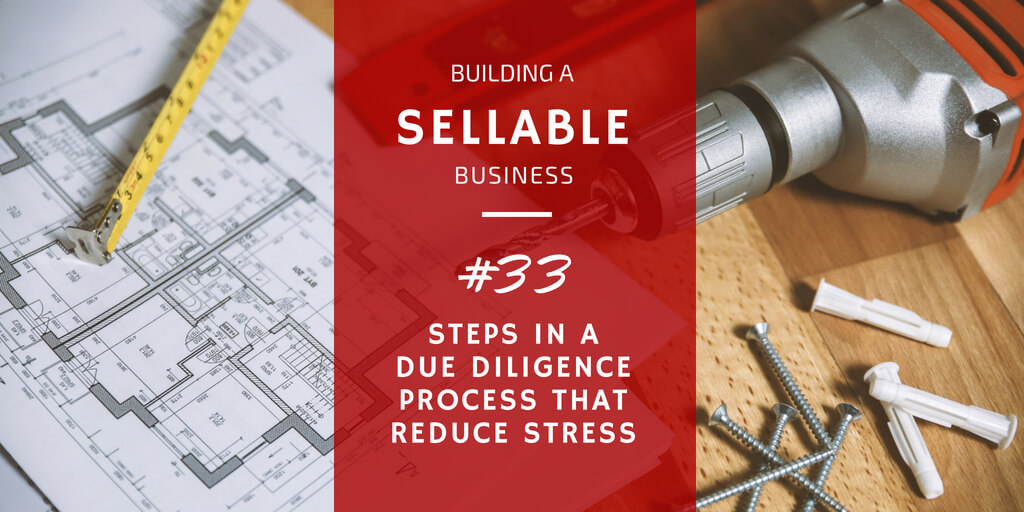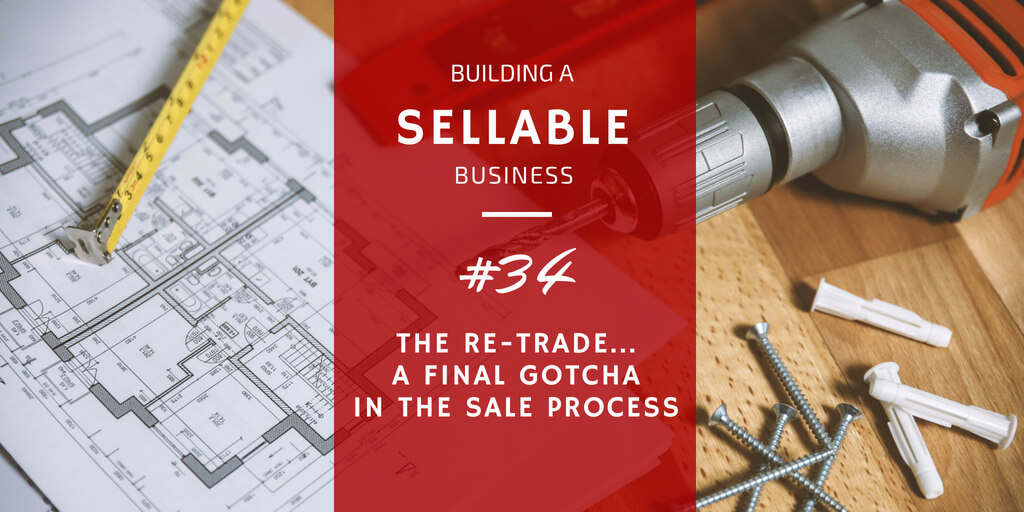
6 Steps in a Due Diligence Process of Your Business’s Sale – Post #33
May 17, 2018
The Tax Cuts and Jobs Act Brings Changes for Business Depreciation
May 22, 2018The Re-Trade in a Business Sale… The Final Gotcha – Post #34

The due diligence period has just wrapped up, and teams are finalizing everything for the sale of your business. You’re ready for the “payday” – but then you get a call from one of your exit team members. The buyer has asked for a last-minute price reduction… a re-trade. Hearing those words will either have you wondering, “what’s a re-trade?”, or if you have done this before, send you into a tailspin of anxiety. Whichever person you are, you need to know why re-trades in a business sale occur so that you can see if there is anything you can do in advance to avoid hearing that dreaded word.
Podcast Time Index for “What is a Re-Trade and How Can I Possibly Avoid It?”
00:30 – What is a Re-Trade and how can I possibly avoid it?
01:13 – What is a Re-Trade?
02:12 – The Bait and Switch
04:23 – Bait and Switch in Business
05:25 – How to avoid a Re-Trade Scenario
05:37 – Prepare your company
06:53 – Keep projections conservative
07:50 – Be ready to walk away from the table
08:38 – Check out the Buyer beforehand
09:21 – Never procrastinate
10:04 – Timing, timing, timing
10:31 – What if you’re in a Re-Trade situation?
12:41 – In summary
What is a Re-Trade in a Business Sale?
Steven Sneiderman, law partner and Mergers & Acquisitions expert, describes a re-trade as “an unanticipated adverse modification to the previously agreed to terms and conditions of a transaction, most frequently in the purchase price.” An unanticipated adverse modification sounds pretty bad, doesn’t it? But what does it mean? In my financially simple terms, a re-trade is a renegotiation of the purchase agreement, which usually means that the purchase price is going down.
Currently, re-trade in a business sale is most common in the business broker’s world. Frankly, because M&A Advisors and Investment Bankers usually perform a higher level of due diligence, have more team members at their disposal, and have better technological systems available to them than business brokers typically do, their business sales do not undergo re-trades as often as those of the business broker. However, re-trades can and do still occur under each facilitator’s guidance.
Two Primary Situations for a Re-Trade
Due Diligence Uncovers Unknown Information Before the Initial Offer
Oftentimes, a re-trade happens when the due diligence process reveals something unexpected about the company that poses a risk for the buyer, costs him money, or simply makes him uncomfortable.
Let’s say the buyer unearthed skeletons that will have an effect on the company after the closing date. What if a terminated employee has threatened to file a lawsuit? Assuming the buyer still wants to purchase the company, he will probably lower his offer to assume that risk. He’ll have to purchase extra liability insurance, and he might have to spend time and money on a legal battle. Therefore, he’ll offer less for the business.
Sometimes during a lengthy due diligence process, the company’s performance will suffer, and its profitability will wane. Other times, sellers inflate their future performance predictions. Buyers realize this when financial reports provided at the end of the due diligence process do not match the profitable prediction of the seller’s pro forma. In those instances, the buyer will probably lower his offer.
What if a landlord will not honor the building rental agreement for the buyer? After purchasing the business, the buyer may have to find new retail space and move equipment, assets, and inventory. Costs to do that add up, and the buyer may request a lower purchase price to cover those expenses.
The Buyer Uses a Bait and Switch Method on the Seller
Unexpected circumstances often come up during business sale negotiations, and the buyer lowers the purchase price for legitimate reasons. However, some buyers plan to re-trade since the process started.
I’ve seen buyers lock sellers up in a Letter of Intent and then drag their feet intentionally during the due diligence process. Thinking the company is as good as sold, buyers relax their marketing or selling. But then, the company doesn’t perform as expected, and here comes the buyer demanding a re-trade. I consider this particular instance an intentional bait and switch.
RELATED STORY: Tips for Creating the Best Business Sales Presentation
Another type of bait and switch I’ve seen buyers use is the strong-handed re-trade. Some buyers intentionally drag out the discovery process, or the due diligence process, to outlast any other interested buyer. By the time due diligence ends, the buyer lowers the purchase price knowing that the seller is exhausted and has no buyers still interested in the company.
How Can You Avoid a Re-Trade?
No matter why a re-trade occurs, the word can cause nightmares for us business owners. So how can we avoid this reduction in the purchase price?
1. Prepare your company.
This point seems obvious if you’ve listened to any of this series. But as I’ve mentioned many times before, you must prepare for the future. If you’ve prepared your company correctly, you will have a close-to-accurate idea of your company’s value before you enter into the due diligence process.
2. Keep your projections as conservative as possible.
Don’t set the value of your company too low when you offer it for sale, but don’t inflate its value either. I worked with one particular client who inflated her company’s financial projections on her pro forma against our exit team’s advice. Ultimately, the buyer drug out the due diligence process to see if her projections could come to fruition. When they did not, he lowered his purchase offer significantly. If the client had been more honest, more prepared, and more conservative in her projections, she might have prevented the re-trade.
3. Be ready to walk away from the table.
While this option is risky, like a game of roulette, it can be extremely effective. So many times I’ve seen sellers so eager to sell they forget that they can walk away if they have to. Now, some sellers can’t walk away. I get that. However, some have the power to walk away or threaten to walk away if the buyer lowers the purchase price. While threatening to walk can prevent a re-trade, it can also dissolve the business sale. So if you threaten to walk, be prepared to walk.
4. Check out the buyer before you enter into the agreement.
Like I mentioned in Post #33, do some due diligence on the buyer. What is his history? Is re-trading a standard operating procedure for him? Does he make high offers for businesses, drag out the discovery process, and then offer far less in a re-trade? Is the buyer approved for financing, or does he still need approval for financing? Use this due diligence time to determine the buyer’s suitability.
5. Never procrastinate.
When the seller can provide the buyer with requested (and accurate) information in a prompt manner, the buyer often views the seller as a strong, confident, prepared candidate. If you consistently provide information in a timely manner, it can build confidence on the buyer’s side that your company is worth what you’re asking for it.
Additionally, if you know you have skeletons in your company’s closet, preemptively identify them. Only then can your exit team help you prepare for the fall-out that might occur. If your team and the buyer know the “sordid” details from the beginning, then teams can set an appropriate purchase price to prevent a re-trade.
6. Don’t try to sell in a bad market.
A CPA friend of mine recently told me that, “if real estate is about location, location, location, then the business sale is about timing, timing, timing.” In some ways, he’s correct. Trying to sell a business in a bad market usually doesn’t work. In a bad market, you’re likely to set yourself up for a re-trade, so use common sense here.
How Can You Tell if a Buyer is Bluffing?
So what do you do if you’re working with a buyer who says, “I’m lowering the price of my offer”? How do you tell if the buyer is bluffing or strong-arming you? Like I said, some buyers are practicing the bait and switch method. How do you tell if this is what your buyer’s doing?
Well, most simply, see if his actions match his words. Is he “playing hard to get” or playing with your emotions? Maybe he’s saying he’s not interested anymore, but he’s still hanging around your company. He’s still asking your employees questions and calling to check on your business. He’s still “around.” Sure, he may say, “take this offer or leave it,” but he’s hovering. That can indicate that his new offer is a bluff to see if he can get you to lower your purchase price.
Now, I will say this. If you or your team call the buyer and get no response, that is his response. If you said no to the re-trade, and then the buyer doesn’t accept any more correspondence from you, he’s gone. He wasn’t bluffing. So be sure a buyer’s bluffing before you say “No” to the re-trade.
Remember, The End is Near
Re-trades can be frustrating, especially this late in the selling process of your business. They don’t have to be, though. You can prepare yourself long before you get to that point. You can take certain actions to avoid a re-trade or to prevent it from happening. If you find yourself in a re-trade situation, though, you still have options to protect yourself and minimize the damage.
Like I always say, life is hard. Life is complicated. Business can be complicated. Re-trades in a business sale can be frustrating to everyone involved, even the buyer. Money doesn’t have to be this way. Let’s continue to make our lives, at least, financially simple.
And the next, and worst step in the sales process – what happens if the buyer backs out of the sale? We will give you common reasons why it happens so you pre-plan for the possibility.




